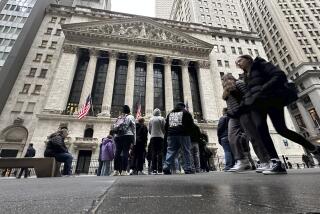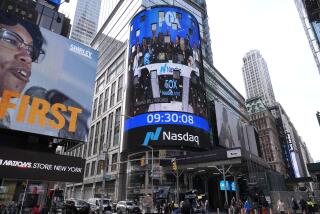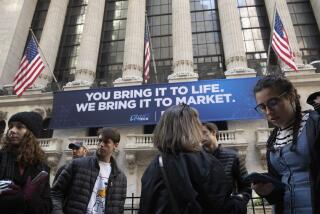Levi Strauss IPO: Stock surges nearly 32% in first day of trading

Levi Strauss & Co. shares hit the New York Stock Exchange on Thursday morning, marking the second Wall Street debut in the iconic jeans maker’s 166-year history.
Late Wednesday, Levi’s priced its initial public offering at $17 a share — higher than the estimated range — valuing the company at $6.6 billion.
The stock began trading Thursday morning on the New York Stock Exchange under the LEVI ticker symbol. The exchange loosened its dress code for the day so traders could wear denim.
The shares drew a warm reception from investors, surging 31.8% to close at $22.41 a share.
Levi Strauss was publicly traded from 1971 to 1985, then was bought in a leveraged buyout by the Haas family, descendants of the company’s namesake founder. Analysts called Thursday’s IPO a financial boon for the Haas family. Even after the IPO, the family maintains roughly 80% of the voting shares.
Since Chief Executive Chip Bergh took over the San Francisco company in 2011, Levi’s has overhauled its image. In the last few years, it has dodged threats from “athleisure” companies and other denim sales. Last year, Levi’s posted $5.6 billion in sales, up 14% from the year before.
The retailer raised $623.3 million in its IPO, selling almost 36.7 million shares Wednesday. The amount raised makes it the biggest listing on a U.S. exchange so far this year — at least until ride-hailing giant Lyft Inc. launches its own offering next week.
But Levi’s path hasn’t always been smooth. Analysts said the brand — which credits itself with inventing blue jeans in 1873 — had lost its way by the 2000s. At the time, Levi’s struggled to come up with an answer to why shoppers should turn to it instead of high-end designers that floated on celebrity endorsements and expensive price tags. (True Religion’s jeans, for example, sold for hundreds of dollars and were paraded around by Britney Spears and Mariah Carey.)
“Consumers never really fell out of love with Levi’s, and no one wanted them to fail,” said Diana Smith, associate director of retail and apparel at the research firm Mintel. “They just forgot about Levi’s because the brand wasn’t giving them a reason to stick around. They lost a decade of consumers.”
That all changed with Bergh’s new vision, which focused on making Levi’s a part of modern pop culture, Smith said. That included partnerships with popular brands such as Off-White and Vetements, and making a mark in the sports and music scenes. Levi’s Stadium is home to the National Football League’s San Francisco 49ers, and the company turns out at festivals such as Coachella.
“That’s been a key part of becoming more of a lifestyle brand and resonating with younger consumers,” Smith said.
Any brand has to contend with changes in consumer tastes. So in the last decade, Levi’s — rather than refusing to budge from its classic 501s — changed its tune.
“They’re in the fashion space, which is to say they’re rocking and rolling with what customers want, as opposed to saying: ‘This is Levi Strauss. Take it or leave it,’” said Mark Cohen, director of retail studies at Columbia Business School.
Bergh shifted the company’s focus toward female shoppers. He has said that Levi’s average shopper, which used to be a 47-year-old man, is now likely to be a 32-year-old of any gender.
The company has also been a force in political and social debates. In September, Levi’s said it was pledging more than $1 million toward nonprofits and youth activists working to end gun violence. Levi’s also announced plans to join former New York Mayor Michael R. Bloomberg in creating a cohort of business leaders who support gun control.
Bergh said at the time that it was “inevitable that we’re going to alienate some consumers, but we can no longer sit on the sidelines and remain silent on this issue.”
All told, Bergh’s strategy has responded to changing fashion tastes — and changing views about the world, said Paula Rosenblum, co-founder of Retail Systems Research. That has been a ticket to attracting millennial shoppers, Rosenblum said, many of whom expect their favorite brands to take cultural issues head-on.
Rosenblum pointed to one of Levi’s recent commercials, called “Circles.” Set to a quick beat, the video shows groups of families and friends from around the world dancing together. Close-ups of denim pants and shorts take a back seat to shots of friends embracing or kicking their legs in the air. The end of the ad flashes the words: “Men, women, young, old, rich, poor, gay, straight,” followed by the tagline, “Let’s live how we dance.”
The ad captures an international — and youthful — embrace for Levi’s, Rosenblum said. Ultimately, Levi’s test has been to hold on to its American roots and stay relevant around the world.
Levi’s is so iconic, Rosenblum said, that when she visited what was then the Soviet Union in the 1970s, passersby on the street would ask if they could buy her jeans.
“Jeans are a symbol of the coolest part of America,” Rosenblum said. “And Levi’s has positioned itself as the de facto coolest of the cool. You’ve got this American concept of jeans, and then you’ve got the grandpa of jeans, which is Levi Strauss.”
Times staff writer James F. Peltz and Bloomberg contributed to this report.






